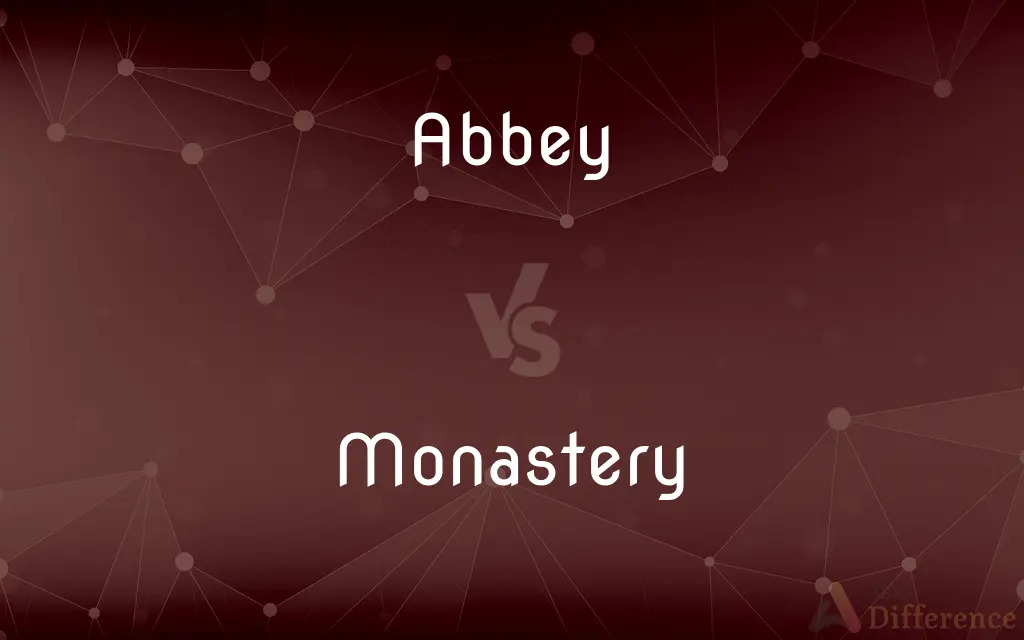Abbey vs. Monastery — What's the Difference?
Edited by Tayyaba Rehman — By Fiza Rafique — Updated on September 25, 2023
An abbey is a complex of buildings housing a community of monks or nuns, often led by an abbot or abbess, while a monastery is a general term for any residence of monks or nuns dedicated to religious life.

Difference Between Abbey and Monastery
Table of Contents
ADVERTISEMENT
Key Differences
An abbey typically refers to a religious complex and its community, often headed by an abbot or abbess. A monastery, on the other hand, is a broader term, denoting a residence for monks or nuns, regardless of their leadership structure.
An abbey is generally recognized by its formal leadership structure, led by an abbot (for monks) or an abbess (for nuns). A monastery might or might not have such specific leadership and could exist within an abbey.
The term abbey can refer to the buildings, the church, and the community dwelling within it. Monastery generally pertains to the living quarters and the religious community, without specifying its architectural or hierarchical significance.
Historically, abbeys have often been significant landowners and centers of learning and culture. Monasteries have varied functions based on their religious orders, focusing on prayer, study, work, or a combination.
Comparison Chart
Definition
A religious community led by an abbot/abbess.
A residence for religious persons, either monks or nuns.
ADVERTISEMENT
Leadership
Typically led by an abbot or abbess.
No specific leadership structure implied.
Usage
Refers to the entire religious community, church, and buildings.
Primarily refers to living quarters and the religious community.
Historical Role
Often landowners and centers of culture and learning.
Varied roles based on religious orders.
Ecclesiastical Status
Higher status with specific rights or privileges.
General term without specific ecclesiastical distinctions.
Compare with Definitions
Abbey
A church that was once part of a monastery or convent.
They attended Sunday service at the abbey.
Monastery
A place of residence for people dedicated to religious life.
The secluded monastery was nestled high in the mountains.
Abbey
A title bestowed to certain churches historically or due to significance.
Westminster Abbey is a famous historical landmark in London.
Monastery
An establishment of a monastic order.
The Franciscan monastery was known for its charitable works.
Abbey
A complex of buildings housing a religious community.
The ancient abbey stood tall amidst the village.
Monastery
A community of monks or nuns.
The monastery had a rigorous daily schedule of prayer and labor.
Abbey
A religious community under the leadership of an abbot or abbess.
She decided to join the abbey and devote her life to prayer.
Monastery
A place for religious seclusion and contemplation.
He spent a year in a monastery seeking spiritual insight.
Abbey
A house of canons or canonesses, regulars, or nuns.
The abbey was known for its strict adherence to the Rule of Saint Benedict.
Monastery
A building or buildings occupied by a community of monks or nuns.
Visitors marveled at the ancient artwork within the monastery.
Abbey
An abbey is a type of monastery used by members of a religious order under the governance of an abbot or abbess. Abbeys provide a complex of buildings and land for religious activities, work, and housing of Christian monks and nuns.
Monastery
A monastery is a building or complex of buildings comprising the domestic quarters and workplaces of monastics, monks or nuns, whether living in communities or alone (hermits). A monastery generally includes a place reserved for prayer which may be a chapel, church, or temple, and may also serve as an oratory, or in the case of communities anything from a single building housing only one senior and two or three junior monks or nuns, to vast complexes and estates housing tens or hundreds.
Abbey
A monastery supervised by an abbot.
Monastery
A community of persons, especially monks, bound by vows to a religious life and often living in partial or complete seclusion.
Abbey
A convent supervised by an abbess.
Monastery
The dwelling place of such a community.
Abbey
A church that is or once was part of a monastery or convent.
Monastery
A residence for monks or others who have taken religious vows.
Abbey
The office or dominion of an abbot or abbess.
Monastery
A house of religious retirement, or of secusion from ordinary temporal concerns, especially for monks; - more rarely applied to such a house for females.
Abbey
A monastery or society of people, secluded from the world and devoted to religion and celibacy, which is headed by an abbot or abbess; also, the monastic building or buildings.
From 1199 to 1203 William Punchard was the abbot of the abbey of Rievaulx, which was part of the Cistercian order of monks.
Monastery
The residence of a religious community
Abbey
The church of a monastery.
Abbey
(British English) A residence that was previously an abbatial building.
Abbey
A monastery or society of persons of either sex, secluded from the world and devoted to religion and celibacy; also, the monastic building or buildings.
Abbey
The church of a monastery.
Abbey
A church associated with a monastery or convent
Abbey
A convent ruled by an abbess
Abbey
A monastery ruled by an abbot
Common Curiosities
Are all religious communities in monasteries called monks or nuns?
Generally, male members are monks and female members are nuns, though specific names can vary by religious tradition.
Do all monasteries follow the same religious practices?
No, practices vary based on religious orders and traditions.
Are all monastic individuals in seclusion?
Not all. Some orders engage actively with the outside world, while others prioritize seclusion.
Can a monastery be part of an abbey?
Yes, a monastery can exist within an abbey, as the abbey includes the entire religious complex.
What's the primary difference between an abbey and a monastery?
An abbey is led by an abbot/abbess and has a specific hierarchy, while a monastery is a general term for any religious residence.
Is every abbey led by an abbot or abbess?
Typically, yes. An abbey is recognized by its leadership of an abbot (for monks) or an abbess (for nuns).
Can an abbey exist without a monastery?
An abbey typically encompasses the religious community, which would include the monastery, or living quarters.
Can laypeople visit abbeys and monasteries?
Many abbeys and monasteries welcome visitors, though some may have restrictions or specific visiting hours.
Are there differences in the architecture of abbeys and monasteries?
While both can have unique architectures, abbeys often have grander structures due to their status and historical significance.
Are abbeys only found in Christianity?
While commonly associated with Christianity, similar institutions exist in other religions, though they might not use the term "abbey."
Are all abbeys historical or old?
While many abbeys have historical significance, new abbeys can still be established.
Are there educational institutions associated with abbeys?
Historically, many abbeys were centers of learning and some continue to operate schools or colleges today.
Can there be multiple monasteries within an abbey?
While uncommon, larger abbeys could potentially house multiple distinct monastic communities.
Do abbeys and monasteries always have churches?
Many do, as worship is central to their lives, but it's not a strict requirement.
Why might someone choose to live in a monastery?
Reasons vary, but many are drawn to a life of spirituality, contemplation, and service.
Share Your Discovery

Previous Comparison
Jupiter vs. Zeus
Next Comparison
Discipline vs. PunishmentAuthor Spotlight
Written by
Fiza RafiqueFiza Rafique is a skilled content writer at AskDifference.com, where she meticulously refines and enhances written pieces. Drawing from her vast editorial expertise, Fiza ensures clarity, accuracy, and precision in every article. Passionate about language, she continually seeks to elevate the quality of content for readers worldwide.
Edited by
Tayyaba RehmanTayyaba Rehman is a distinguished writer, currently serving as a primary contributor to askdifference.com. As a researcher in semantics and etymology, Tayyaba's passion for the complexity of languages and their distinctions has found a perfect home on the platform. Tayyaba delves into the intricacies of language, distinguishing between commonly confused words and phrases, thereby providing clarity for readers worldwide.















































